|
Montana & Glacier National Park
22nd July - 1st August 2008
|
|
Harvey left Yellowstone Park with three extra
passengers. We gave a lift to three Taiwanese employees of
the park, who were bound for Bozeman for a shopping trip on their days off
work. Asta, Ting and I-Ying were very excited to find we were
headed all the way, 90 miles, to Bozeman too.
|
|
Having learned a lot about Taiwan, we dropped
our new friends off at their hotel in Bozeman. We were
soon re-united, however, when we headed to Wal-mart to
restock!
A shock was in store for us on leaving Wal-mart
with our heavily laden shopping trolley. We had been
oblivious to the severe storm which had passed over whilst we'd been
shopping. We found ourselves ankle deep in flood water in the parking
lot. With some ingenuity we managed to get the groceries
back to Harvey dry, but our feet were a different matter!
|
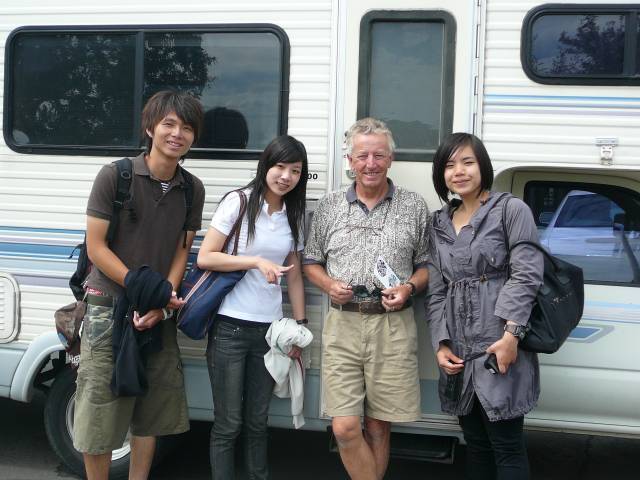
Our Taiwanese friends.
|
|
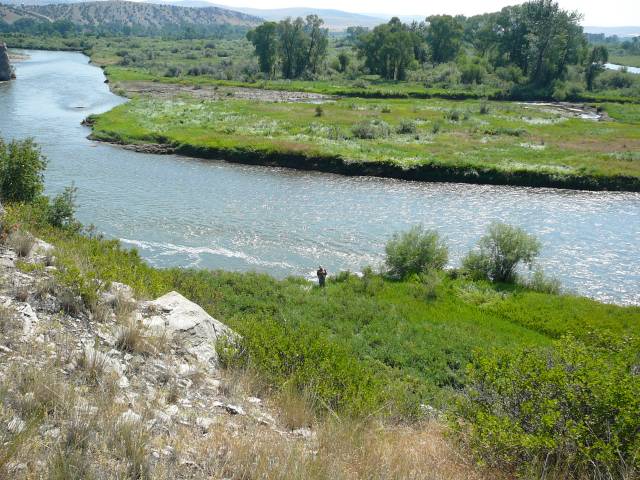
Phil fishing the Missouri
Headwaters
|
On recommendation from locals, we headed to the
Missouri Headwaters State Park to camp and fish. Our first
evenings fishing was abandoned, however, due to another wild
thunderstorm. There was certainly a lot of wild weather to worry
about in the USA.
Next day, fishing gear on hand, we explored
the park. We visited spots pretty much unchanged in the 200
years since their exploration by Lewis and Clark, during their epic journey
in search of a northwest water passage across the country. On
reaching this location guided by their Shoshone guide Sacagawea, they found
that the Missouri river was formed there by the confluence of three smaller
rivers. Believing that none of the these three waterways was large
enough to be considered as the Missouri, they had named them after prominent
politicians Jefferson, Madison and Gallatin.
|
|
The park's many historical and geological
landmarks kept us entertained but the fishing proved disappointing. It
seemed the current was still running too swiftly. It was hot and
we watched a group of local teenagers struggling to swim across the river
whilst being swept rapidly downstream. At the Park we encountered
Harvey's identical twin, driven by Billings artist Dick Ellis and compared
notes for a while.
Next morning we hit the road for Glacier
National Park, encountering murky weather and major roadworks on the
way. After spending the night in a commercial campground
just outside the park, to deal with domestic chores, we headed into the Park
early the next morning to ensure we'd find a campsite before they
filled. We were in luck and found a wonderful site at the Rising
Sun campground. No sooner had we settled in, than the
cleaning crew set to work!
|
|
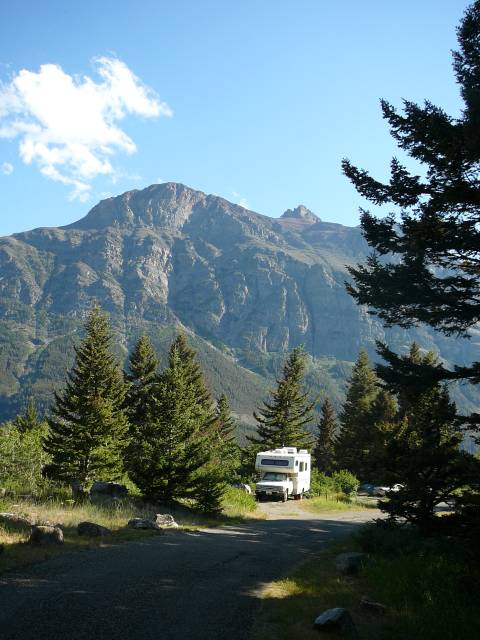
Harvey at Rising Sun
Campground
|
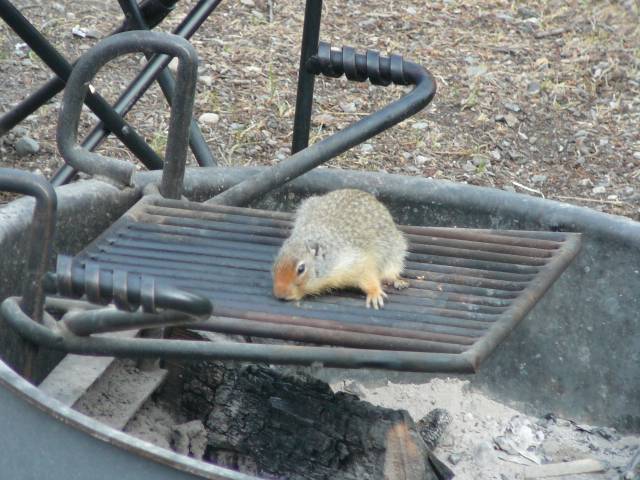
Grill cleaning
ground-squirrel crew at work.
|
|
The major artery through the park from east to
west was the 50 mile "Going To The Sun Road".
Whilst Harvey was of a size on the limit of vehicles permitted to cross the
highway, we decided it would be prudent to make the most of the free shuttle
bus service to check it out first, before subjecting him to the
trip. The weather was perfect to make the most of the
striking, alpine scenery.
The bus service was excellent, although our
bus to Logan Pass proved troublesome. Half way to the pass, the
rear passenger doors refused to close. Built-in safety
features on the vehicle prevented it from moving with the rear doors
open. For a while the driver struggled to force the doors
closed, with assistance of passengers eager not to be stranded.
Finally we reached Logan Pass up at 6646 feet and exited through the front
of the bus. We had to change to much smaller minibuses for the next
leg of the journey.
|
|
This part of the trip took us around the
stunning hair-pin bend, known as The Loop and through the section of road
undergoing major roadworks. At the roadworks we were
delayed for around 20 minutes at a single lane section of road, giving us
the chance to get out of the bus and admire the view.
We knew Harvey could have made the trip but
bearing in mind the perilous sections of over-hanging rock, narrow lanes at
the roadworks on sheer cliff edges, steep climb and poor road surface, we
decided that the free bus was definitely the way to cross the
mountains. Harvey would be taking the considerably longer
but much quicker route westwards around the southern edge of the park.
|
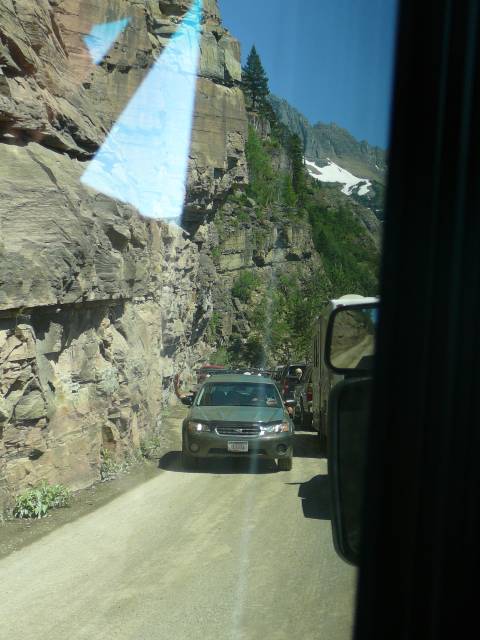
Do not lean out of the
window.
|
|
Next day, again on local recommendation, we made
a stop at Lost Lake for a spot of fishing. The lake's name
was certainly justified as it was not visible from the road, only a short
distance away. Unsigned and hidden by surrounding trees it
was a peaceful spot and we hooked enough trout for dinner for ourselves and
a German camper who adopted us that evening at our campfire.
From Sun Point we took the trail to St. Mary
and Virginia waterfalls, a three mile stroll along St. Mary Lake through
beautiful woodland. Part way along we were passed by a
speedy team of rangers with an ingenious stretcher, supported by one bicycle
wheel. They were on their way to the falls to recover a
casualty with an ankle injury. The one-wheeled stretcher
certainly made transporting a casualty along the rough trails much easier.
|
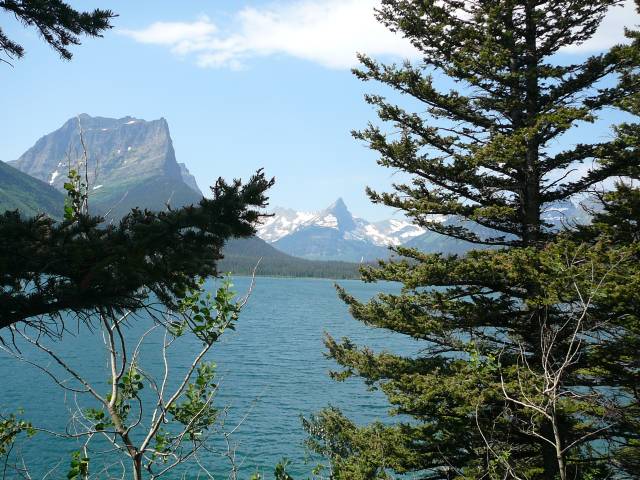
St. Mary Lake
|
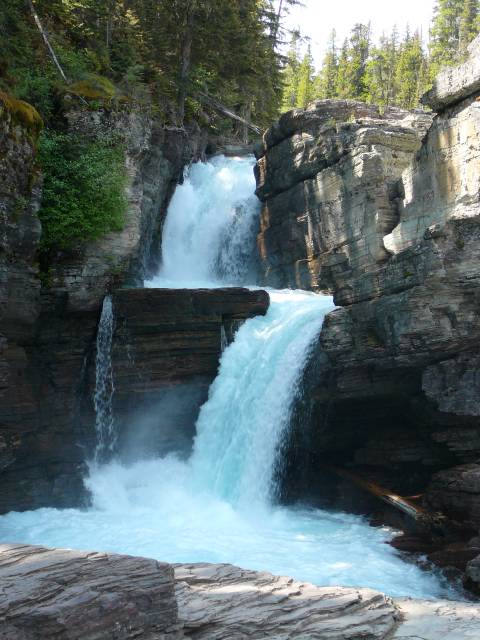
St. Mary Falls
|
|
Our next trip on the shuttle bus did not start
smoothly. Due to a breakdown (which looked suspiciously like the
bus with dodgy doors!), we waited over an hour for the trip up to Logan
Pass. We wanted to take some photographs of the stunning
scenery and take a look at the Highline Trail. After
a short stroll on the vertiginous Highline Trail, perched precariously on a
steep slope, we had our photographs and decided to head back to the visitor
centre. On the return trip, we realised we had passed inches
beneath a mountain goat and kid resting overhead on the cliff face and
hadn't even noticed.
|
|
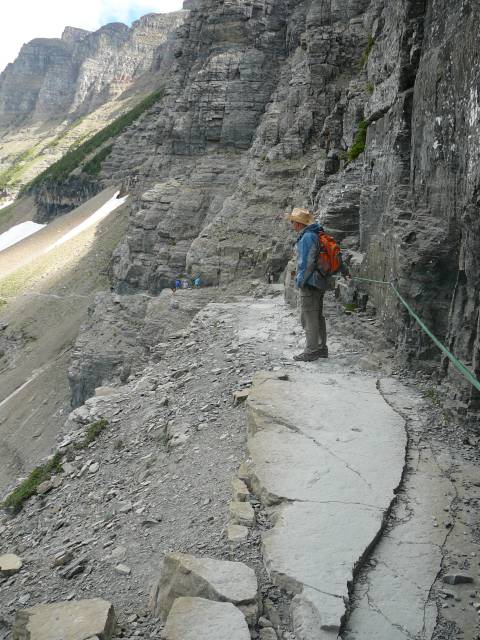
|

Highline Trail, perfect
territory for mountain goats.
|
|
From the visitor centre we took the trail to
Hidden Lake. The walk began as a stroll on boardwalk through
alpine wildflowers in full bloom. We set off in company
with many other tourists but soon the number thinned dramatically when those
in flip-flops and Crocs reached the snow line. We hiked
across several long snow sections and caught up with a Ranger led tour,
where we tagged along learning about the wildlife and flora we passed along
the way. The ranger also pointed out perilous snow bridges
we should walk around, where water was running under thin layers of ice,
which could collapse at any time. This certainly was not
flip-flop territory.
|
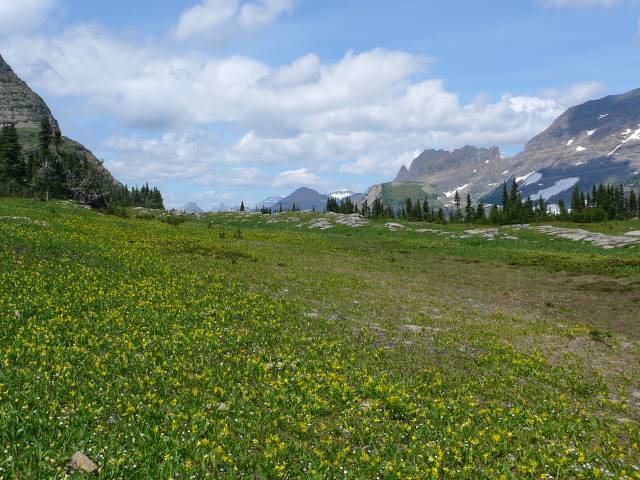
Logan Pass Meadows
|
|
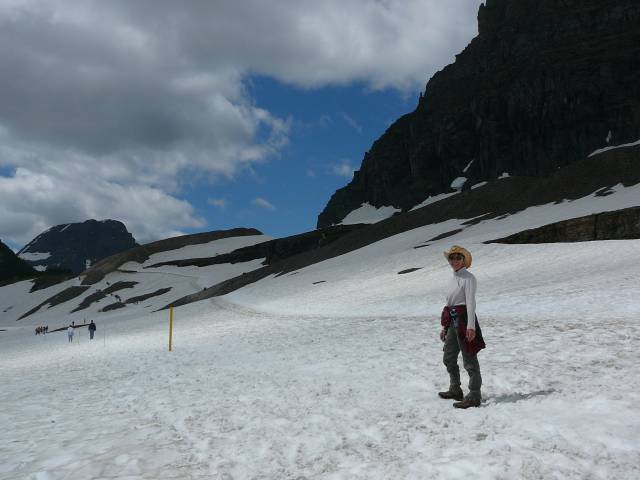
|
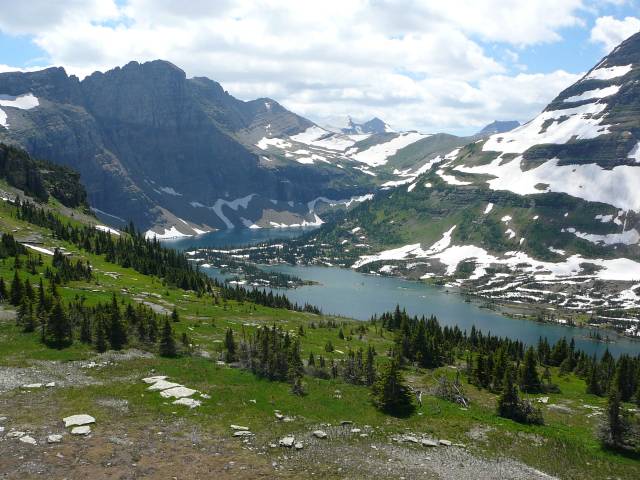
|
|
After passing foraging mountain goats, dwarf
alpine pines, which spent the winter buried under snow and cheeky
opportunistic ground squirrels, we finally reached the Hidden Lake
Overlook. Our ranger was explaining the geology of the
area to the group, when suddenly a distraught lady ran up and asked the
ranger for help. Apparently her husband had collapsed and was
turning blue whilst suddenly covered in a rash. From
leading a pleasant afternoon stroll, educating tourists about
wildlife, our ranger suddenly found herself racing a mile back down
the mountain to deal with a serious case of anaphylactic shock from an
allergic reaction. Luckily all turned out well and it made
us appreciate the multiple talents required of rangers.
Next day we moved campsite to the Many
Glacier area, further north in the park. This site was up
a dead-end road, a very peaceful spot where we could walk to all the
trailheads from our campground. It was time for more fishing and
we selected a four mile trail which took us along a crystal clear creek and
past four lakes. We hiked around four miles to the farthest lake
before we tried our hand at fishing.
|
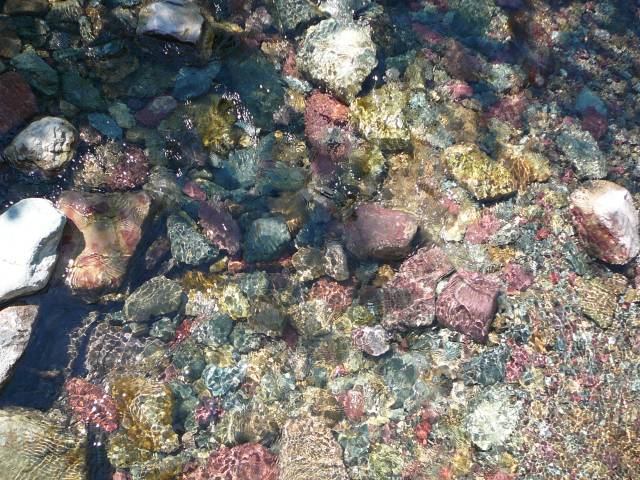
Crystal clear melt waters
|
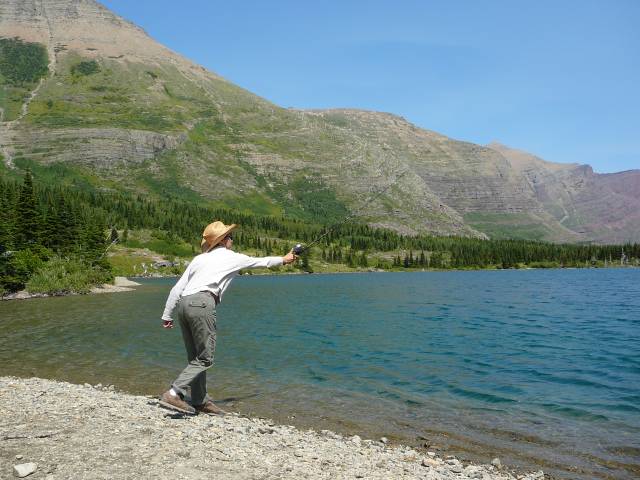
Christine fishing at
Bullhead Lake
|
|
We had no luck with the fishing at the highest
lake, so began to make our way downhill again, trying every likely spot on
the way. Finally in the creek, we hooked a few small trout but
returned them to the water to grow some more. As we passed
the third lake on our return trip, Redrock Lake, we spotted a serious
looking angler carrying a one-man float. Curious, having never
seen this type of fishing before we began chatting and picked up some
fishing tips. It seemed that the float was the best way of lake
fishing in the area, allowing you to drift out into the deeper water,
however he told us of a couple of spots near the campground we could try
without needing a boat or float.
Back at Many Glacier, we found there was to
be a campfire talk by a locally well-known Blackfoot Tribe historian and
entertainer, Jack Gladstone. We dragged ourselves along on our
weary feet and were not disappointed. He gave us a very
entertaining insight into Blackfoot tradition and history through his
stories and songs.
When the next day dawned wet, cold and grey
we rested our hiking legs, only venturing out to explore the historic Many
Glaciers Lodge across the lake from our campsite. Luckily
the next day brought much improved weather, allowing us to hike up to
Grinnell Glacier, a five mile steep ascent. Again we encountered
stunning views, alphine flora in full bloom, snow, and even a waterfall
through which we had to walk.
|
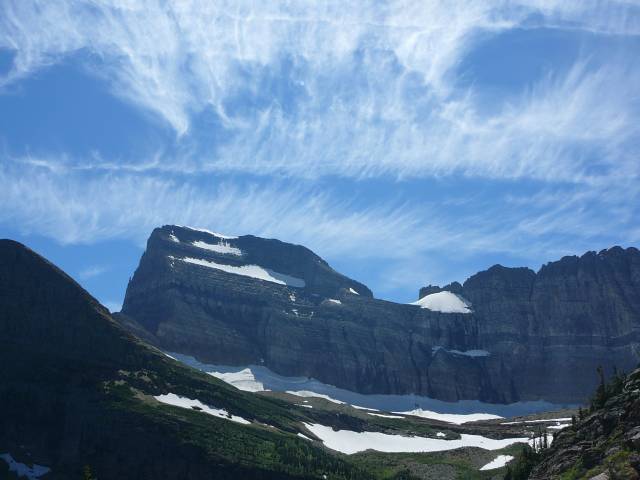
Grinnell Glacier
|
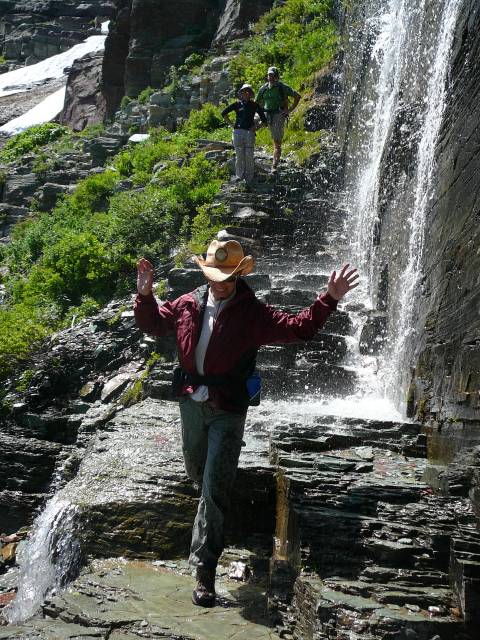
Braving the slippery rocks
and ice cold waterfall
|
|
On our downhill return hike we were prepared for
the ice water dunking at the waterfall, having dried out from the soaking
during our ascent. Our next peril was an encounter with a
Bighorn Ram. Normally sheep are not considered
particularly dangerous but this variety truly lived up to their name and it
wasn't only the horns that were big. The animal was about the
size of a deer and grumpy because we and two other hikers on the trail had
come between him and where he wanted to be, to rejoin his
buddies. We had effectively cut him off from his planned
route and he was most unhappy about the situation. As we
tried quickly to get out of his way, he began to look threatening, head and
horns down in our direction. Luckily the situation resolved
itself as we all hurried by and he continued on his way. We were
glad it wasn't a grizzly we'd encountered!
|
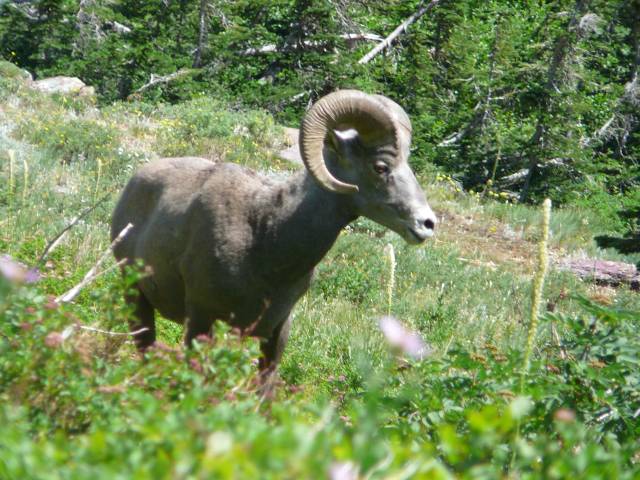
|
|
Our last campsite in Glacier Park was at Two
Medicines in the south of the park. We took advice from the
ranger on where to fish but on attempting to reach the spots she had
mentioned, found ourselves deep in undergrowth, bushwhacking to reach the
water. Berries were ripening all around us and we felt a little
nervous of the bears which may be nearby to feast on the sweet
berries. Reaching the water was hard work and finally we
gave up and returned to camp.
Later Phil walked to a slightly more
accessible but equally berry filled area, bear-spray in hand just in
case. He returned with a beautiful trout for dinner.
|
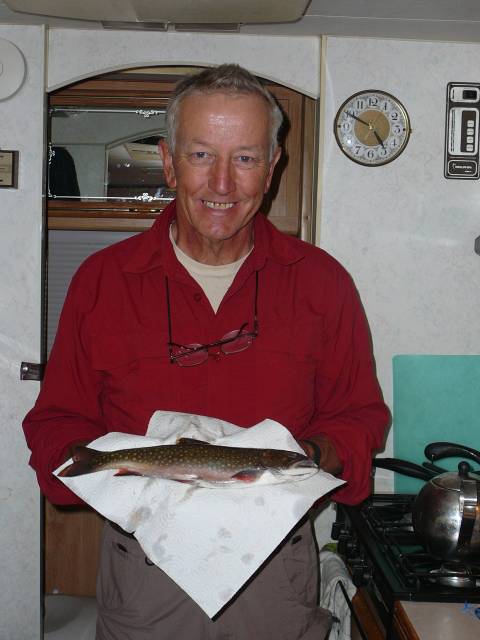
|
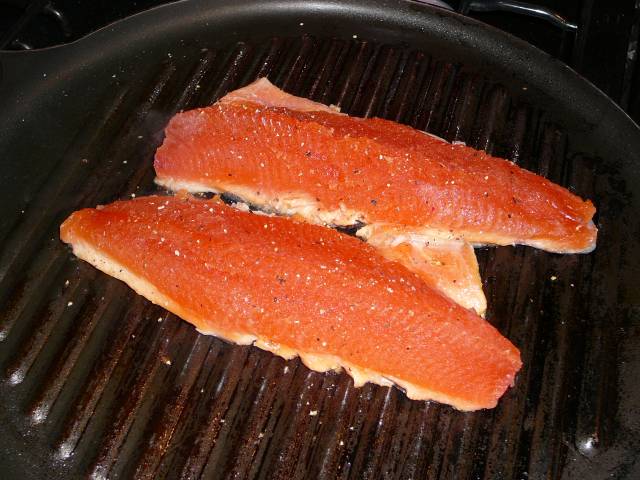
|
|
There was plenty more to see and do in Glacier
Park but we felt it was time to move on. Hopefully we'd get the
chance to visit again in the future.
|


















